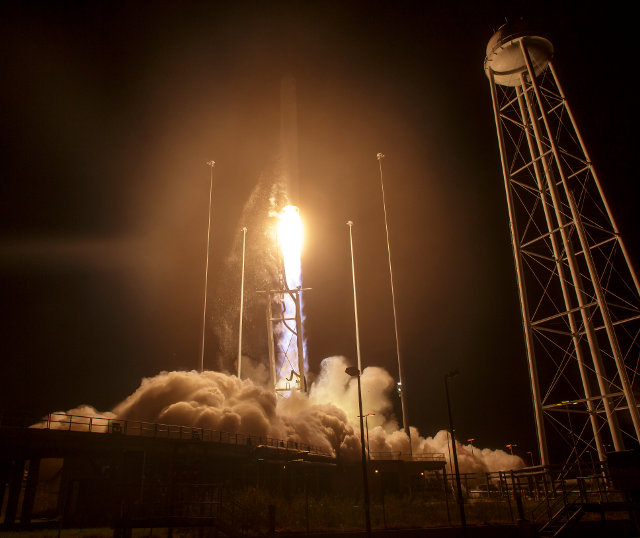
It was late afternoon in California when Orbital ATK’s Cygnus spacecraft blasted off atop an Antares rocket from the Mid-Atlantic Regional Spaceport (MARS), part of NASA’s Wallops Flight Facility (WFF) on Wallops Island. After about nine minutes it successfully separated from the rocket’s last stage went en route to its destination. This is its sixth official mission, called Orbital-5 or simply Orb-5 but also CRS OA-5, to transport supplies to the International Space Station for NASA.
This Cygnus spacecraft was named “Alan Poindexter” after the astronaut who was part of the crew of two space missions on the Space Shuttle Atlantis and Discovery. This is the third Cygnus in the new more advanced version that entered service in December 2015.
The new version of the Antares rocket, called Antares 230, uses the RD-181 engines that should have greater reliability but also better performance than the AJ26, which were actually old Soviet NK-33 built in the late ’60s and the beginning of the ’70s refurbished. After the explosion of an Antares in October 2014, Orbital ATK decided to accelerate the development of its rocket’s new version.
The Cygnus spacecraft carries a total of 2,342 kg (5,163 lbs) of cargo that include 585 kg (1,290 lbs) of various types of supplies for the crew, 1,023 kg (2,255 lbs) of hardware and the rest in equipment and various components including some needed for a number of the scientific research conducted on the International Space station.
The Cool Flames experiment aims to study low-temperature combustion of droplets of a variety of fuels and additives in microgravity conditions. Several experiments on combustion have been conducted on the International Space Station because it’s important to understand how fire acts in those conditions to establish how to act in case of fire but also to improve engines and fuels to be used in space.
The Lighting Effects study is of medical type and aims to improve the International Space Station crew’s health. By studying the effects of different types of light on human beings, they can adjust those of the Station to try to reproduce the circadian rhythms, the daily ones we’re used to on Earth. It will be useful not only during space missions but also for people with jobs that include night shifts.
The EveryWear studio will record and transmit data about certain activities of the International Space Station crew, including meals, sleep, exercise and medications. Using an application for tablets, the astronauts will answer questionnaires and keep a medical diary of their mission. A “smartshirt” equipped with sensors will directly collect medical information while the astronauts do their physical exercises. Other sensors will collect data during sleep and a barcode reader will collect data on the food eaten.
The Fast Neutron Spectrometer (FNS) experiment is intended to collect more information on the exposure of astronauts but also of electronic equipment to radiation in space using a new technique. This new equipment captures neutrons in special lithium-filled glass fibers. This causes a bright flash that is recognized and analyzed.
The Cygnus spacecraft is scheduled to reach the International Space Station on Sunday to be captured by the robotic arm Canadarm2 around 10 UTC. Generally the journey of space cargo ships is faster but tomorrow the launch of new Station crew members is scheduled and they have a priority. If there are no problems, the day after the Cygnus arrival the crew will open the hatch and can begin its unloading.
NASA published a clip of the Antares rocket launch.


Permalink